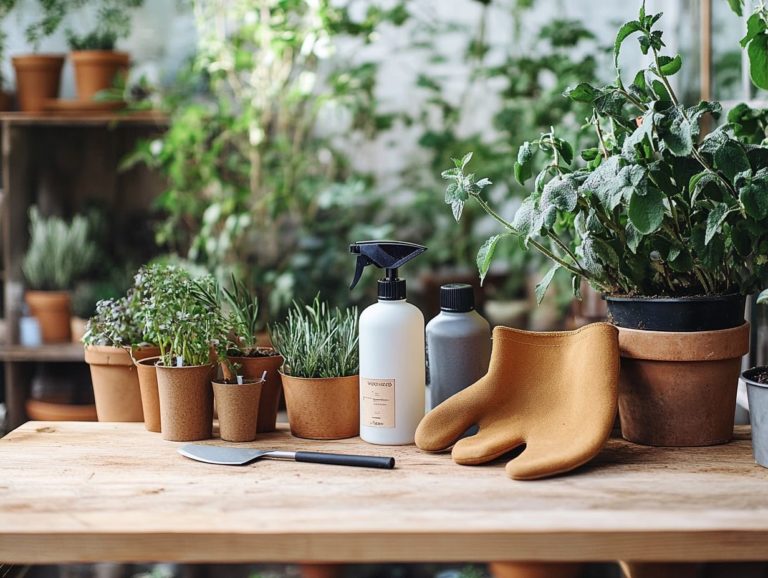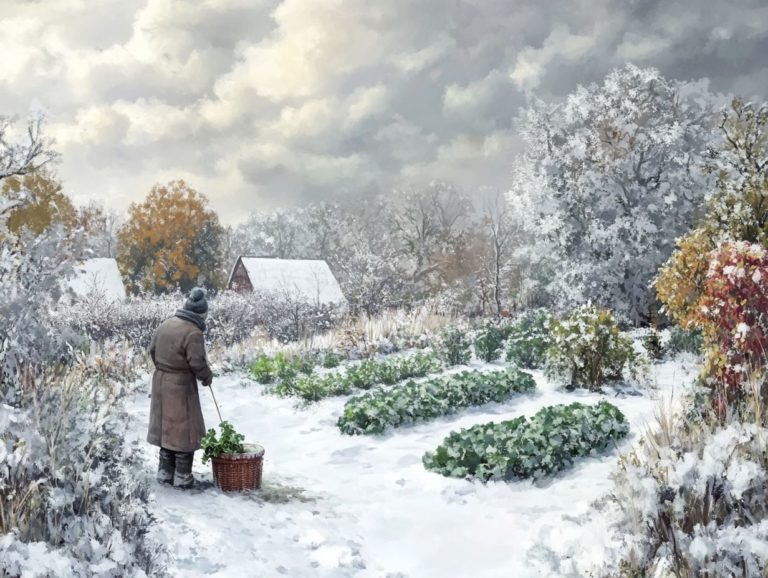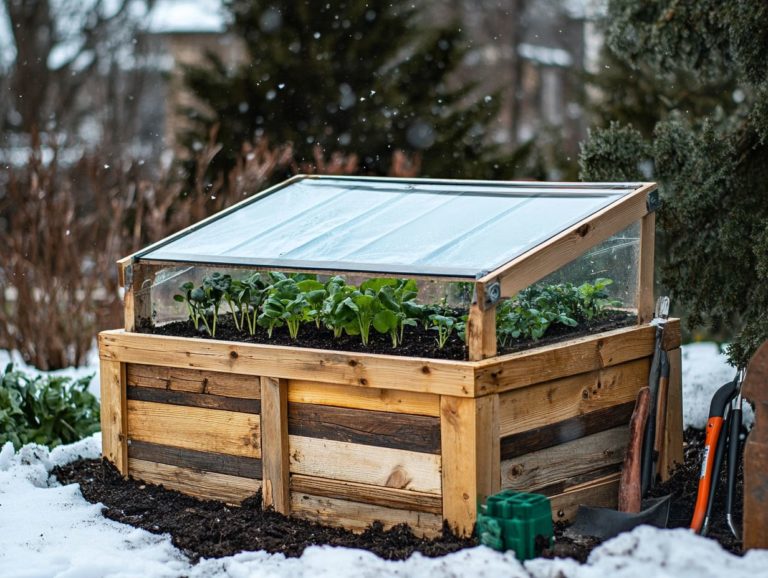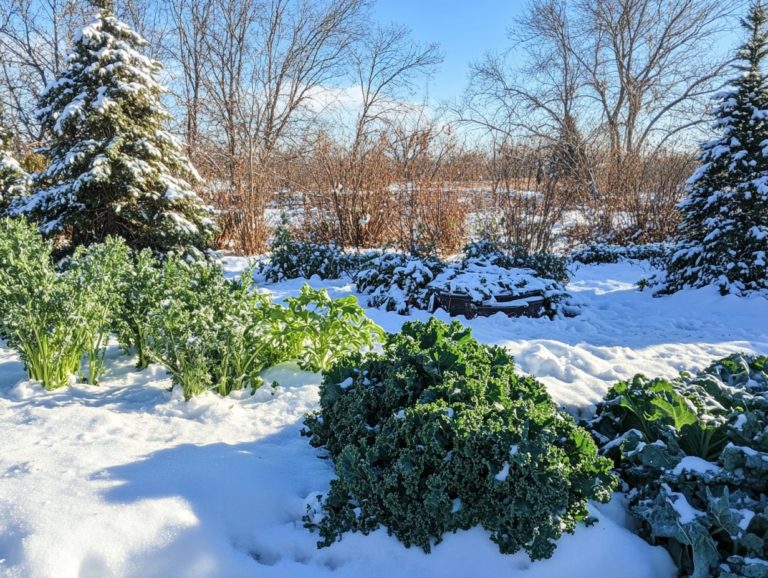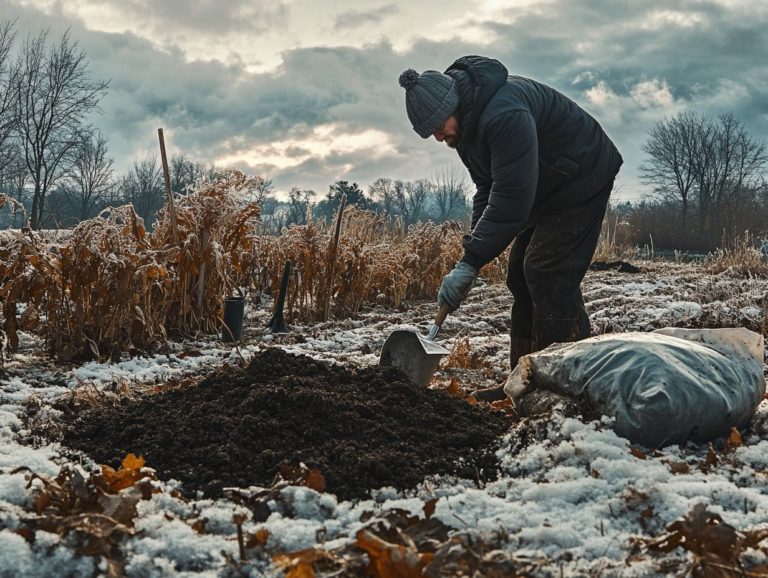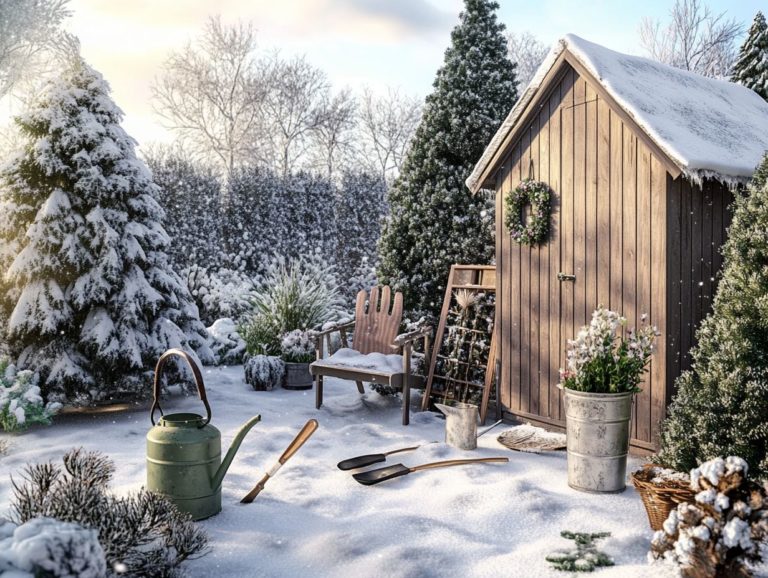Essential Gardening Tools for Cold Climates
Gardening in cold climates offers a unique blend of challenges and opportunities that require specialized knowledge and tools. From combating frost to maximizing limited sunlight, having the right equipment and techniques can truly transform your gardening experience.
This article delves into essential gardening tools designed specifically for cold weather, guiding you on how to select and maintain them effectively. It also shares practical strategies to safeguard your plants against harsh conditions.
Whether you re a seasoned gardener or just beginning your journey, get ready to uncover essential tips that will help your garden thrive through winter!
Contents
- Key Takeaways:
- Must-Have Gardening Tools for Cold Climates
- Tips for Choosing and Maintaining Gardening Tools
- Gardening Techniques for Cold Climates
- Frequently Asked Questions
- What are some essential gardening tools for cold climates?
- Why is it important to have the right tools for gardening in cold climates?
- Do I need to purchase special tools for gardening in cold climates?
- Can I use regular gardening gloves for gardening in cold climates?
- Do I need to use a watering can or hose for gardening in cold climates?
- What essential tools should I use for gardening in cold climates?
Key Takeaways:
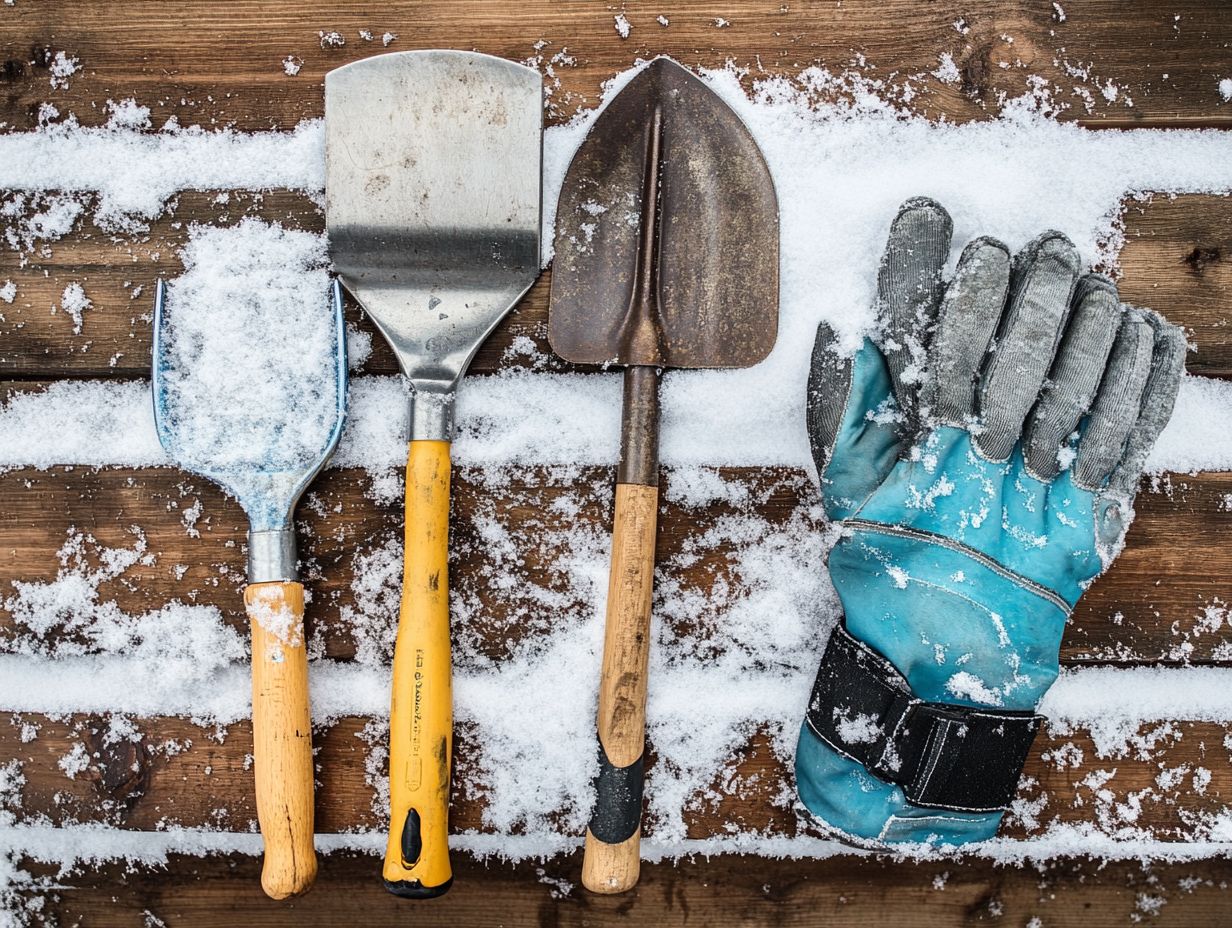
- Invest in frost covers and insulated gloves for winter.
- Maintain your tools for long-lasting use.
- Use raised beds and maximize sunlight to boost growth.
What Makes Cold Climate Gardening Unique
Cold climate gardening has its own set of challenges and opportunities that set it apart from gardening in warmer regions. With low temperatures, snow cover, and shorter growing seasons, you ll need specific knowledge and techniques to keep your vulnerable plants healthy and productive.
Understanding these factors is crucial for successful winter gardening, where protecting your plants becomes key to maintaining your garden s vitality. As you face soil erosion and changing weather, it s essential to adapt your gardening practices to thrive in these unique environments.
One significant hurdle you ll encounter is the risk of frost heaves, which occur when freezing and thawing push roots out of the soil, disrupting growth. It s important to choose plant varieties that are resilient to frost and can withstand the challenging conditions common in winter.
Using tactics like mulching, building cold frames, and selecting heat-retentive materials can significantly enhance the survival chances of your delicate plants. Additionally, understanding the small areas with different climates in your garden will allow you to strategically position plants to shield them from biting winds and heavy snow accumulation.
By embracing these protective measures, you can successfully cultivate a thriving winter landscape in the face of cold climate gardening.
Must-Have Gardening Tools for Cold Climates
Equipping yourself with the right gardening tools is essential for managing a garden in cold climates. Utilizing essential tools for winter gardening success can transform your gardening experience, making a noticeable difference in your tasks.
Whether it s high-quality implements or specialized winter gardening gear, having the right equipment enhances efficiency and streamlines irrigation management. Plus, don t overlook protective gear; it s crucial for your safety while tackling cold-weather tasks.
This allows you to focus on maintaining a pristine garden and maximizing productivity during those chilly months.
Shovels, Rakes, and Other Basic Tools
Basic gardening tools like shovels and rakes become your best allies in maintaining a flourishing garden, especially in colder climates where upkeep demands more effort. These essential implements are crucial for managing garden debris, constructing mulch layers for winter protection, and prepping raised garden beds for late-season planting.
By learning to use these tools effectively, you can elevate your gardening experience, keeping your garden clean and organized throughout winter.
As temperatures dip, the urgency for proper maintenance increases. Choosing the right shovel whether it s a spade for digging or a snow shovel for clearing pathways can transform your approach to winter gardening. Rakes also serve a versatile role; they gather dead leaves and help distribute mulch evenly, providing insulation for your plants against frosty nights.
Opting for a rake with a comfortable grip minimizes strain on your hands during lengthy clean-up sessions. Regularly checking your tools for wear and tear can extend their lifespan and maintain their efficiency. By mastering the art of using these vital implements, you’ll navigate seasonal changes with ease and grace.
Specialized Tools for Cold Climate Gardening
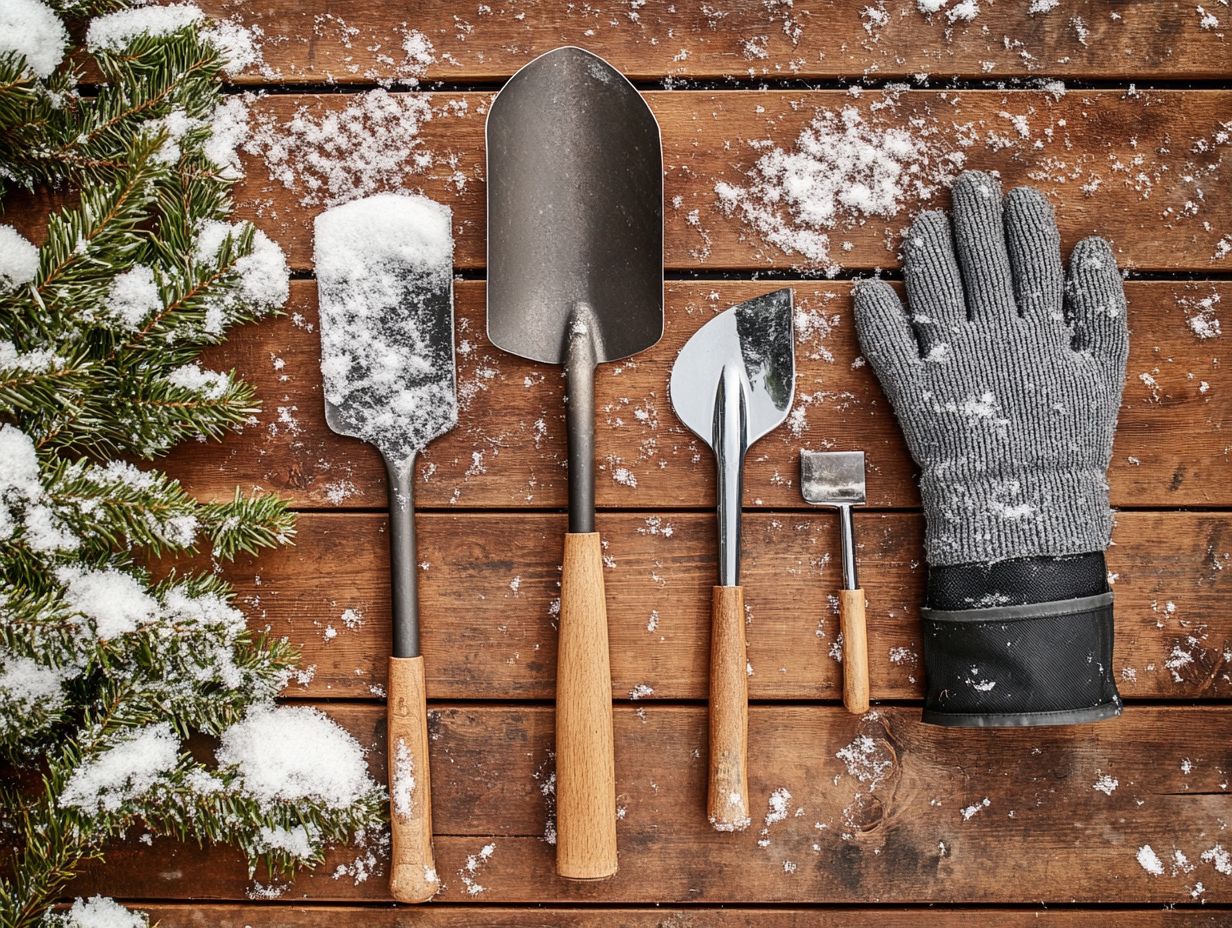
Specialized tools are crucial for your success in cold climate gardening. Unique challenges call for innovative solutions, and using the right equipment can make a significant difference. For instance, exploring the top 10 composting tools for cold climates can help you optimize your gardening efforts. Pruning shears are essential for effective plant care, allowing you to maintain healthy growth and enhance your yield.
Plant covers offer crucial winter protection against harsh weather. Meanwhile, grow lights ensure your seedlings thrive even in low-light conditions. A compost bin is perfect for turning organic matter into rich fertilizers that will nourish the soil during the colder months, leading to a more fruitful gardening experience.
Frost blankets and row covers protect tender plants from unexpected temperature drops. Cold-hardy varieties can thrive with tailored techniques, such as proper pruning in late winter, which encourages vibrant new growth come spring. Incorporating organic fertilizers boosts soil fertility, promoting nutrient availability and enhancing overall plant health.
By embracing a combination of these specialized tools and techniques, you can navigate the rigors of colder climates, ensuring your garden flourishes even in the harshest conditions.
Tips for Choosing and Maintaining Gardening Tools
Choosing and maintaining the right gardening tools is essential for achieving optimal results in cold climate gardening. Utilizing essential tools for winter garden prep ensures that good quality tools pave the way for success.
You have many tasks, like managing soil erosion and pest control. Choosing the right tools for these tasks is vital. Proper maintenance not only extends the lifespan of your equipment but also ensures you have reliable tools at your disposal throughout the gardening season.
By investing in protective gear and refining your gardening expertise, you can cultivate a more efficient and enjoyable gardening experience.
Factors to Consider When Buying Tools
When you’re purchasing gardening tools for cold climates, several factors need consideration to ensure you’re investing in equipment that meets your gardening needs effectively, including the top 5 essential cold-climate plant food tools.
Essential tasks like weed removal or late-season planting require tools that are not only good quality but also designed to be comfortable to use to reduce strain during use.
By evaluating the specific demands of cold climate gardening, you can select tools that withstand challenging weather conditions and discover helpful gardening tool hacks for cold weather to enhance your overall gardening experience.
Focusing on functionality is key; your tools should be versatile enough to handle a range of tasks from digging to pruning to sowing. Look for materials that are durable and resistant to rust and corrosion, especially when facing frost or snow.
It’s also wise to consider designs that prioritize comfort and grip, particularly for prolonged use in colder temperatures. Opting for tools with warranties can provide peace of mind, ensuring your investment is secure and that you have reliable gear throughout the gardening seasons.
Proper Maintenance and Storage Techniques
Proper maintenance and storage techniques are essential for extending the lifespan of your gardening tools, especially during the winter months when they might not see much action.
Take a moment to clean each tool after use removing dirt, sap, and debris thoroughly can significantly enhance their longevity. For tools susceptible to rust, a thin layer of oil acts as a protective barrier against moisture, keeping them in top-notch condition.
As winter approaches, it s prudent to winterize your tools by storing them in a dry location. Ideally, hang them up to prevent contact with damp surfaces. Enclosing them in breathable covers can provide additional protection from dust and potential damage.
By adopting these practices, you ensure your tools are ready for action, showcasing your gardening skills and dedication!
Gardening Techniques for Cold Climates
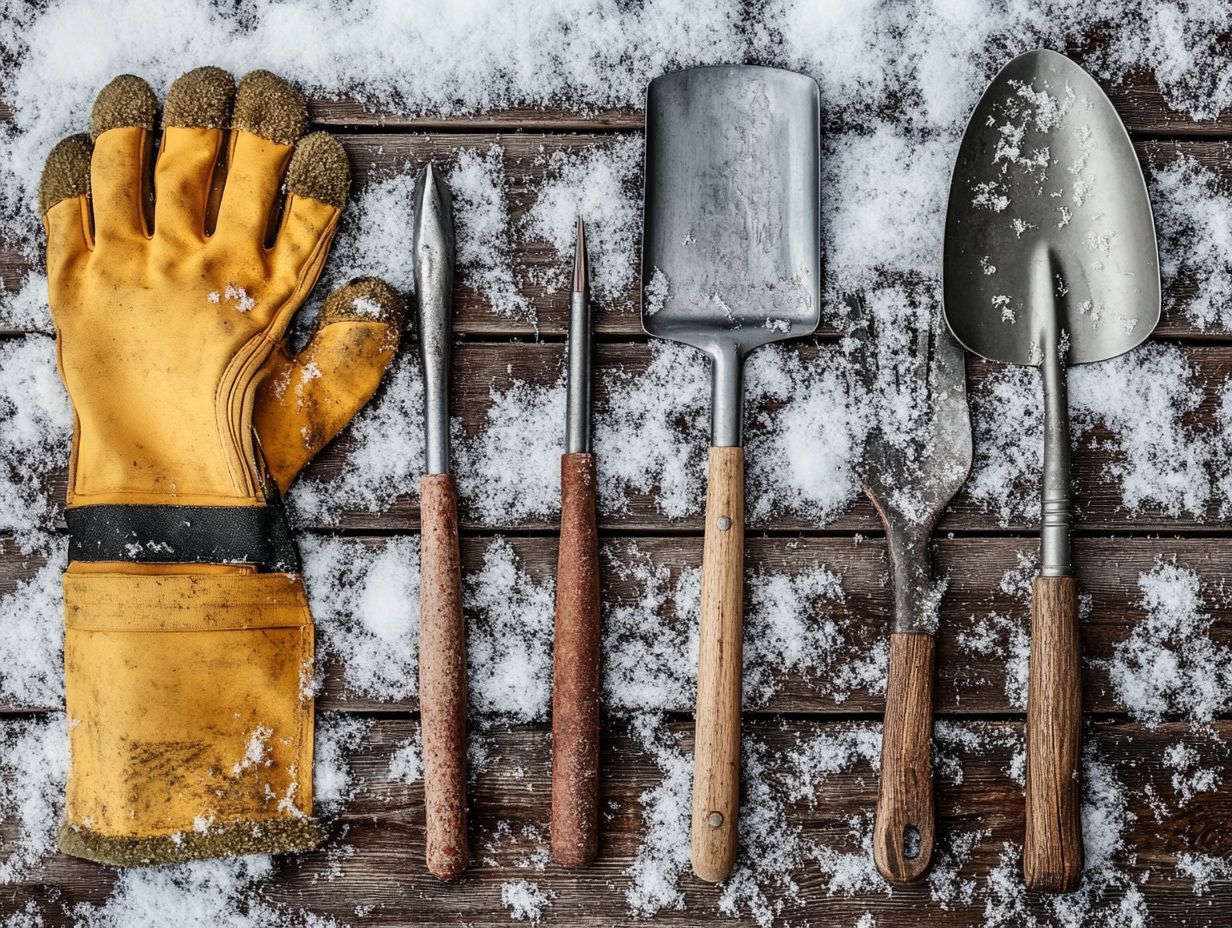
Don t wait! Start preparing your garden now to ensure your plants survive and flourish this winter! Mastering gardening techniques tailored for cold climates is crucial for nurturing your plants through the winter season. The right practices can make a significant difference.
Implementing effective frost protection measures will safeguard your vulnerable plants from freezing temperatures. Utilizing cold frames structures that protect plants from cold while allowing sunlight in can create a microclimate that encourages growth during the harshest winter months.
Understanding late-season planting strategies helps you maximize yields while ensuring your plants’ health as they gracefully transition through the colder season.
Protecting Plants from Frost and Snow
Protecting your plants from frost and snow is essential, especially in colder climates where freezing temperatures threaten your delicate flora. Using plant covers and horticultural fleece creates a robust barrier against frost, insulating and shielding your plants from harsh weather.
Winter weather can be unpredictable, so it’s essential to stay informed about temperature changes and potential frost. Knowing when and how to deploy your protective coverings is crucial for maintaining your plants’ health. You have several options for plant covers, including:
- Row covers
- Cloches
- Bubble wrap
Each type serves different plants and conditions. By monitoring local weather forecasts and applying these coverings just before a frost, you can significantly reduce the risk of freeze damage. This diligence ensures that your blooms are protected and ready to thrive come spring.
Maximizing Sunlight and Heat in Cold Climates
Maximizing sunlight and heat in cold climates is crucial for promoting growth and health during the winter months. Limited daylight can present challenges, but employing grow lights can extend the growing season and provide essential light for seedlings and delicate plants.
Using a garden planner to organize your planting locations ensures that sun-loving plants receive the exposure they need, optimizing their growth potential even in less-than-ideal weather conditions.
Understanding your local microclimate a small area with a different climate can enhance these strategies. For instance, placing your plants near reflective surfaces like walls or fences can amplify their sunlight exposure. Considering vertical gardening will help you utilize space effectively, ensuring each plant has access to that crucial light.
Incorporating row covers, cold frames, and mulch can help retain heat and protect your plants from harsh winds. Such thoughtful planning fosters a more resilient garden and creates an inviting outdoor space that thrives even in the chill of winter.
Frequently Asked Questions
Curious about essential tools for winter gardening in cold climates? Here are some frequently asked questions that can help you get started!
What are some essential gardening tools for cold climates?
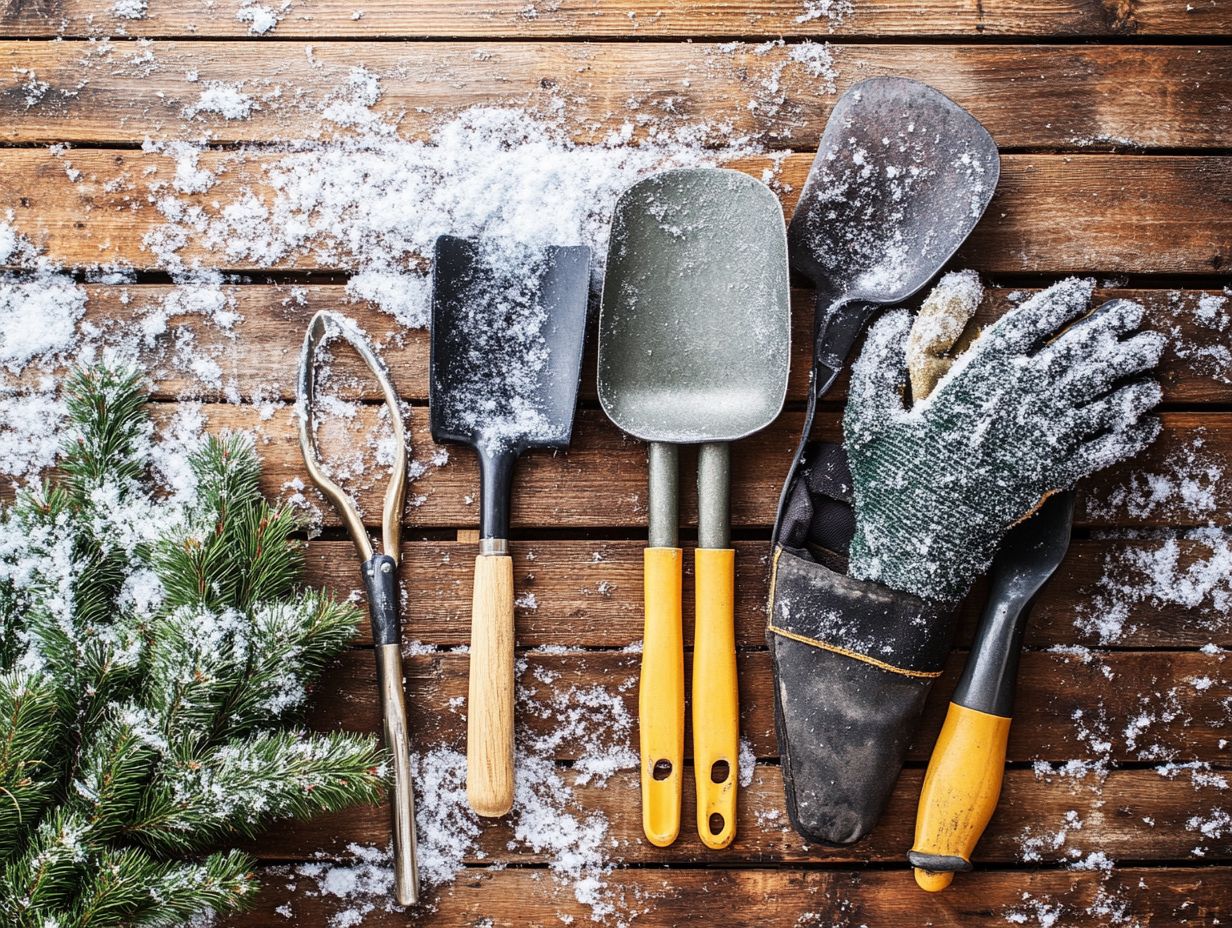
Some essential gardening tools for cold climates include a sturdy shovel, a rake, a hoe, a hand trowel, a pair of gloves, and a watering can or hose. For a comprehensive list, check out what tools are essential for cold-climate gardening.
Why is it important to have the right tools for gardening in cold climates?
The right tools can make gardening in the snow much easier and more efficient. They also help protect your plants from harsh weather conditions.
Do I need to purchase special tools for gardening in cold climates?
While some tools may be specific to cold climates, many can be used in any climate. However, it’s important to choose tools that are durable and can withstand freezing temperatures.
Can I use regular gardening gloves for gardening in cold climates?
Regular gardening gloves may not provide enough protection from the cold. It’s best to invest in a pair of insulated gardening gloves specifically designed for cold climates.
Do I need to use a watering can or hose for gardening in cold climates?
Yes, watering your plants is crucial even in cold climates. Be sure to drain and store your watering can or hose properly to prevent freezing and damage.
What essential tools should I use for gardening in cold climates?
Key tools include a snow shovel, a protective plant cover, and a soil thermometer. These items will help you monitor temperatures and protect your plants effectively.

